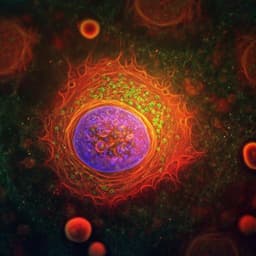
Physics
Active-feedback quantum control of an integrated low-frequency mechanical resonator
J. Guo, J. Chang, et al.
This groundbreaking research by Jingkun Guo, Jin Chang, Xiong Yao, and Simon Gröblacher showcases measurement-based feedback cooling in a fully integrated optomechanical device. Achieving an impressive minimal average phonon occupation confirms the quantum nature of mechanical motion, paving the way for innovative advancements in quantum-limited sensing applications.
~3 min • Beginner • English
Introduction
The study of quantum behavior in macroscopic mechanical resonators enables tests of fundamental physics and supports applications in quantum metrology and communications. However, mechanical motion is typically masked by thermal noise from the environment. Initializing a mechanical mode close to its motional ground state is therefore essential. Prior breakthroughs have demonstrated sub-phonon occupations mainly in the sideband-resolved regime, where the optical cavity linewidth is smaller than the mechanical frequency, facilitating laser-cooling-based techniques. For many sensing scenarios and for low-frequency or larger, more macroscopic resonators, operating in the sideband-unresolved regime is advantageous due to relaxed optical cavity requirements and broader readout bandwidth. Yet, lower mechanical frequency or higher bath temperature increases the initial thermal occupation n_th = k_B T/(ħΩ_m), making cooling more demanding. The present work targets this regime and aims to realize ground-state-level cooling of a low-frequency, integrated resonator via measurement-based feedback, and to validate the quantum nature of the motion through motional sideband asymmetry.
Literature Review
Previous work has established ground-state cooling and quantum control in sideband-resolved cavity optomechanics, often using high-frequency, low-mass devices or millikelvin environments to reduce the initial phonon number. Demonstrations include laser cooling near the zero-point energy and observations of quantum motion and motional sideband asymmetry. More recently, experiments with trapped particles and bulkier, low-frequency systems have also achieved sub-phonon occupations starting from high bath temperatures, frequently leveraging measurement-based feedback. In parallel, the sideband-unresolved regime has gained traction for sensing applications, benefiting from large optical bandwidth and faithful displacement readout without strong cavity filtering. Foundational theory compared feedback (cold-damping) and cavity-assisted cooling and established the importance of measurement rate versus thermal decoherence as well as the role of quantum back-action and detection efficiency. These insights frame the need for devices with large single-photon coupling, high mechanical quality factors, and high total detection efficiency to reach quantum-limited performance in the sideband-unresolved regime.
Methodology
Device and parameters: The integrated optomechanical device combines a soft-clamped, fractal-inspired silicon nitride mechanical resonator (50 nm thick, in-plane size ~0.5 mm) with an evanescently coupled photonic crystal cavity assembled via a pick-and-place method. The fundamental mechanical mode oscillates at ~1.1 MHz (room temperature) with effective mass ~16 pg, and exhibits Q_m ≈ 1.8×10^7 at room temperature, increasing to ~5.1×10^7 at ~18 K. The optical cavity (wavelength ~1550 nm) has linewidth κ/2π ≈ 8.8 GHz with external coupling κ_ex/2π ≈ 6.9 GHz, placing the system deep in the sideband-unresolved regime. Optomechanical coupling is large, with g_0/2π = 224 ± 4 kHz, yielding single-photon cooperativity C_0 = 4 g_0^2/(κ γ_m) ≈ 10^3 at 18 K.
Measurement-based feedback: The mechanical displacement is measured via balanced homodyne detection of the phase quadrature of the reflected cooling laser (on resonance for feedback runs). A phase EOM injects a known calibration tone, enabling absolute displacement calibration using independently measured g_0. The homodyne signal is processed in real time by a digital controller (RedPitaya 125-14) implementing a tailored transfer function and compensating delays (~640 ns with LHe, ~680 ns with LN2). The controller drives an intensity EOM that modulates the input power, creating radiation-pressure forces that provide additional damping. The experimental design minimizes parasitic detection of the intensity modulation; residual leakage was characterized to introduce only ~10^−1 relative error to the feedback force, and fitting yields an effective quadrature leakage parameter ε ~ 10^−6.
Sideband-asymmetry metrology: To verify quantum behavior and independently calibrate energy, an out-of-loop heterodyne detection is performed with a second, red-detuned probe laser. The probe is filtered (κ/2π = 35 MHz) and mixed with a local oscillator detuned by Ω_het/2π = 2.81 MHz using serrodyne shifting. The two motional sidebands in the heterodyne spectrum, unaffected by the feedback modulation and far detuned (by 21 GHz) from the cooling laser detection bandwidth, provide an absolute energy scale: the ratio of Stokes to anti-Stokes sidebands equals n/(n+1). Given Ω_m/κ ≪ 1, cavity filtering corrections are negligible. Spectra are normalized to shot noise for calibration. Phonon number is extracted by fitting both sidebands or by direct integration with noise-floor subtraction.
Detection efficiency and operating conditions: Dual-path measurements (homodyne for feedback and heterodyne out-of-loop) add optical losses and introduce back-action from the probe, degrading the achievable cooling. After validating agreement between the two metrologies, a simplified configuration without the heterodyne path was used to improve total detection efficiency η_det to 0.49 at fixed cavity photon number n_c = 350. Experiments were conducted in a continuous-flow cryostat pre-cooled either with liquid helium (effective mode temperature ~18 K) or liquid nitrogen (77 K).
Data analysis and modeling: Homodyne spectra are normalized to shot noise to remove frequency-dependent detector/electronic response. A semi-classical model in the sideband-unresolved limit incorporates mechanical susceptibility, thermal force noise, measurement imprecision, feedback filter H_fb(ω) with delay, and small quadrature leakage. Fitting parameters include S_F, S_Xmp, g_fb, H_fb, and τ. The inferred displacement spectrum yields the effective phonon number by numerical integration. Heterodyne spectra are fitted using effective mechanical susceptibility under feedback to extract n from sideband sum and difference; alternatively, direct integration around the mechanical peaks with noise subtraction provides a consistency check.
Key Findings
- Device performance: g_0/2π = 224 ± 4 kHz; κ/2π = 8.8 GHz (overcoupled with κ_ex/2π = 6.9 GHz); mechanical Q_m up to ~5.1×10^7 at ~18 K; fundamental frequency ~1.1 MHz at room temperature and ~1.045 MHz at low temperature; effective mass ~16 pg; single-photon cooperativity C_0 ≈ 10^3 at 18 K.
- Feedback cooling at ~18 K with dual-path (homodyne + heterodyne): Minimum phonon occupancy n = 1.06 ± 0.06; clear motional sideband asymmetry observed in out-of-loop heterodyne spectra; phonon numbers from sideband asymmetry agree with calibrated homodyne results.
- Improved detection efficiency run (no heterodyne path): η_det ≈ 0.49 at n_c = 350; minimum phonon occupancy n = 0.76 ± 0.16 (ground-state level). Effective bath temperature inferred from fits (after subtracting back-action) ≈ 18.3 K.
- Cooling from 77 K (LN2): Despite higher decoherence and lower Q_m (≈ 4.1×10^7), observed significant sideband asymmetry; minimum phonon occupancy n = 3.45 ± 0.15 with consistency between homodyne-calibrated and heterodyne-extracted values.
- Initial conditions: Starting from a mechanical mode temperature of ~18 K corresponds to an initial phonon number of ~3.6×10^5 for the ~1.045 MHz mode.
- Measurement–decoherence balance: Analysis with Γ_dec/Γ_meas highlights the importance of high C_0 and high η_det to approach the quantum limit while minimizing heating from intracavity photons and probe-induced back-action.
Discussion
The work addresses the challenge of preparing a low-frequency, integrated mechanical resonator near its quantum ground state in the sideband-unresolved regime, where traditional sideband-resolved cooling is not applicable. By combining a high-Q, strongly coupled device with quantum-limited homodyne readout and optimized feedback filtering, the authors achieve sub-phonon occupations and directly observe motional sideband asymmetry, an unambiguous quantum signature. Agreement between calibrated in-loop homodyne thermometry and out-of-loop heterodyne sideband asymmetry validates the absolute energy calibration and confirms quantum-limited performance. Removing the heterodyne path improves detection efficiency and reduces probe back-action, enabling a lower phonon number (0.76 ± 0.16). At elevated temperature (77 K), the method still produces sizable asymmetry and few-phonon occupations, underscoring robustness for practical sensing. The results show that, with sufficient η_det, large g_0, and careful control of delays and filter phases, measurement-based feedback can overcome thermal decoherence and reach quantum regimes in integrated, sideband-unresolved systems relevant to real-world applications.
Conclusion
This study demonstrates measurement-based feedback cooling of a fully integrated, low-frequency optomechanical resonator in the deep sideband-unresolved regime, achieving a minimum phonon occupancy of 0.76 ± 0.16 with improved detection efficiency and 1.06 ± 0.06 in a dual-measurement configuration. Significant heterodyne sideband asymmetry verifies the quantum nature of the motion and provides an independent, absolute calibration of mechanical energy. The compact device design, strong optomechanical coupling, and simple experimental setup make the approach attractive for quantum-limited sensing and quantum transduction at accessible temperatures. Future work could target further improvements in mechanical Q, enhanced thermalization, and higher overall detection efficiency to enable ground-state operation directly from ambient conditions, as well as exploration of non-classical state preparation and quantum information processing tasks using similar integrated platforms.
Limitations
- Detection efficiency: Additional optical components and simultaneous heterodyne probing reduce η_det and introduce extra quantum back-action, limiting the minimum achievable phonon number in the dual-path configuration.
- Thermalization and heating: The effective mechanical mode temperature (~18.3 K) exceeds the cryostat thermometer reading (~6 K), indicating device heating and imperfect thermal anchoring; photon absorption can raise the bath temperature at higher intracavity powers.
- Elevated-temperature constraints: At 77 K the mechanical Q is reduced (≈ 4.1×10^7), and low-frequency 1/f-like noise from the photonic crystal mode elevates the measurement noise floor, limiting cooling performance.
- Finite bandwidth effects: In heterodyne integration, finite frequency windows miss broadened spectral weight at high feedback gain, reducing apparent asymmetry unless corrected by fitting.
- Delay and mode management: Significant feedback delay requires careful filter design to avoid heating of other mechanical modes; residual quadrature leakage (ε ~ 10^−6) and minor parasitic detection of the intensity modulation (~10^−1 relative error to feedback force) remain.
Related Publications
Explore these studies to deepen your understanding of the subject.







